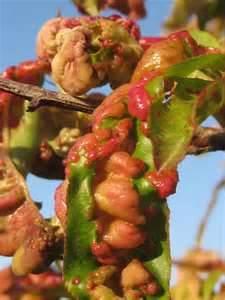Unused stories
Pest of the Month - Peach Leaf Curl
Time to protect your peach tree...
Visions of plump, juicy peaches dance in your head as you tend your fruit trees in the early days of spring; you’re already dreaming of peach pie, ice cream, or fruit plucked warm off the tree. But your daydreams might be squelched by seeing instead, blistered, bumpy, puckered, twisted leaves – not exactly what you’re expecting on your peach tree as it leafs out.
Looks like you have a case of peach leaf curl, a disease caused by the fungus Taphrina deformans. It’s a common disease that affects only peach and nectarine trees, potentially weakening them and reducing yield. Left untreated, it can result in the demise of the tree.

While it’s admittedly not pretty to look at, peach leaf curl is fortunately not difficult to control. Selecting varieties that have some resistance to the disease is the easiest preventive measure. Currently available resistant peach varieties include ‘Frost’, ‘Indian Free’, ‘Muir’, and ‘Q-1-8’. ‘Redhaven’ peach and most cultivars derived from it are tolerant to peach leaf curl; ‘Kreibich’ is one of the few resistant nectarine varieties.
Keeping trees healthy and vigorous, providing adequate water to reduce drought stress, and thinning fruit help to reduce demands on the tree. Along with good garden sanitation – removing diseased leaves, twigs and branches from the garden, these measure go a long way in protecting against infection.
An annual application of a fungicide is usually sufficient to protect the tree, and timing is everything. Apply after leaves fall, usually late November. Treatment in spring after symptoms appear won’t have any effect. If it’s a very wet winter and early spring, a second application just before buds swell may be warranted.
A fixed copper fungicide containing copper ammonium is the easiest to use. You can improve the effectiveness of the material by adding a 1% horticultural spray oil to the application mix. You get a bonus from this as the oil also aids in controlling some aphids, scale insects, and mites. Bordeaux mixture is another option – it is a copper sulfate and lime mixture that should be prepared just prior to use. The synthetic fungicide chlorothalonil is currently the only other non-copper fungicide available to the home gardener for managing peach leaf curl.
Don’t let those forlorn looking leaves deter you; the scrumptious golden orbs of summer are worth the little extra effort that may be needed to keep your peach or nectarine tree healthy and productive!
For more detailed information, click here.
By Nanette Londeree
